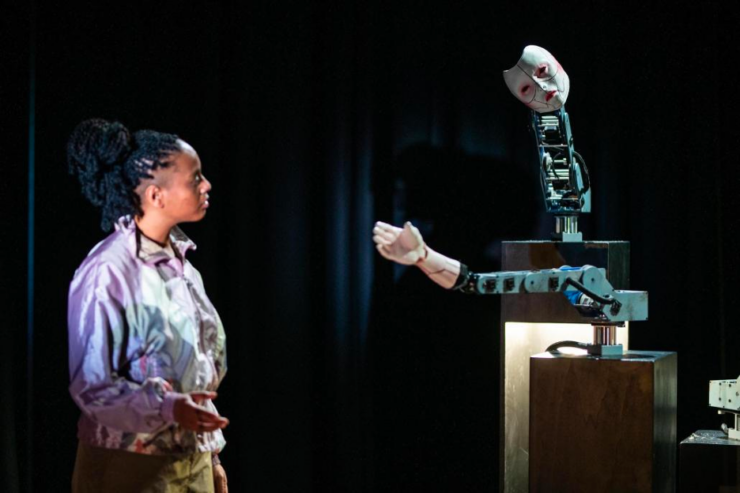Documentation
“A puppet can fly: The more-than-human portrays ultimate humanity” – Lisanne Brouwer

De Foetushemel – Ulrike Quade Company
“It can walk, yes, but that’s not what it does best. Because a puppet can fly.” Ulrike Quade, theatre-maker, researcher and artistic leader of puppet theatre group Ulrike Quade Company, needs but a single sentence to enthral a room full of theatre students and scholars with her fascination for puppetry. On 29 November 2023, we are gathered in a full lecture room at the Drift for a ‘Meet the Makers’ session with the renowned artist, who is also an integral part of Maaike Bleeker’s project Acting Like a Robot. ‘Meet the Makers’ aims to facilitate meetings and conversations between academic researchers and students, and makers from the cultural field. Today, puppetry and, more specifically, robotics, are the topic of analysis. With an unrelenting albeit at times befuddled passion, and this one very sentence, Quade helps us see their potential: by being more than human, puppets and robots open up a space for stories about humanity that humans are unable to tell themselves.
The ‘more-than-human’ is a concept that is mentioned a lot in recent post-anthropocentric work, but one that I have only really begun to understand through this conversation. Quade realised early on, already during her education as a theatre-maker, that she didn’t want to put herself in the centre of the performance. She always looked for ways to take herself, and by extension the main human performer in general, out of the centre, to be replaced by something else – puppetry (and later robotics) as a solution for a desire to make the human as a coherent, unified figure disappear. For her, a performance starts with the visuals, the space, and how a body – or puppet – exists in it. She draws inspiration from the Japanese artform Bunraku, in which one puppet is moved by three puppeteers, and its voice is portrayed by yet another human, further removed, on the side of the stage. The ‘main character’ is being stretched, and shared among the performers, dismantled, displaced, dispersed. It’s a bit of a character, but it’s also the space, the voice. It’s more-than-human.
In De Foetushemel (The Sky of Foetuses), one of the examples Quade has brought along for us, it is not a puppet, but indeed a robot that portrays this dispersed, more-than-human character. To mark what should have been the fiftieth anniversary of the Roe vs. Wade case, legalising abortion in all of the U.S., Simon(e) van Saarloos wrote this piece on “a place where all foetuses can go after their abortion. Where they aren’t pitied, but endless, like goddesses.” The performance tells the story of non-binary Freddie, who enters a world in which the terms abortion, violence and life get a new meaning. A robot, built up out of a face, like a theatrical mask, a hand, and breathing lungs (see picture), welcomes Freddie (whose parent wanted to have an abortion but wasn’t allowed) into this sky of foetuses.
The excerpt reminds me of Alles naar de Hemel (Everything up to Heaven) by puppetry company TG Winterberg, in which two parents find out that their unborn baby will be heavily disabled. As they try to decide to keep the pregnancy or have an abortion, they converse not only with each other, but also with their unborn baby: it features prominently – both alive and dead, like a Schrödingers cat – as a puppet. In dreamlike sequences the baby expresses its doubts about its own potential existence. In another work, Excavations, artist Marijs Boulogne creates a stillborn baby out of embroidery. When the artist learns about the years of grief that a physician experienced for their stillborn baby, she is struck by how even medical professionals do not have a way to deal with such a loss. In response, she creates a tangible narrative around the topic, using puppetry. The performance shows an autopsy, in which the baby’s organs, embroidered in detail, are shown through a handheld camera and an actual endoscope. This dissection of an embroidered baby allows the artist and spectator to shed light on and experience that which we as humans are unable to portray.
The fact that these works all revolve around new (human) life and the precarity, complexity, and vulnerability of that, can’t be a coincidence. It seems as if the more-than-human is able to make tangible these fundamental, deeply human topics of life and death, in a way that human performers will never quite be able to. The fact that puppets and robots are not alive, or at least not in the way humans are, allows them to become, in a way, tangible figures of the imagination. In our minds, we can imagine any body and any state of liveness. We can imagine interacting with a dead person, an unborn child, a severely disabled baby. We can imagine them flying. With puppets, we are able to shape the bodies of those imaginations and make them real, even touch them. Puppets and robots can walk, yes, but unlike humans, they can fly. They can break apart, be dissected, and reassemble. They can die and come alive again. They can be simultaneously alive, and dead. Precisely because they are not human, they can be more.

